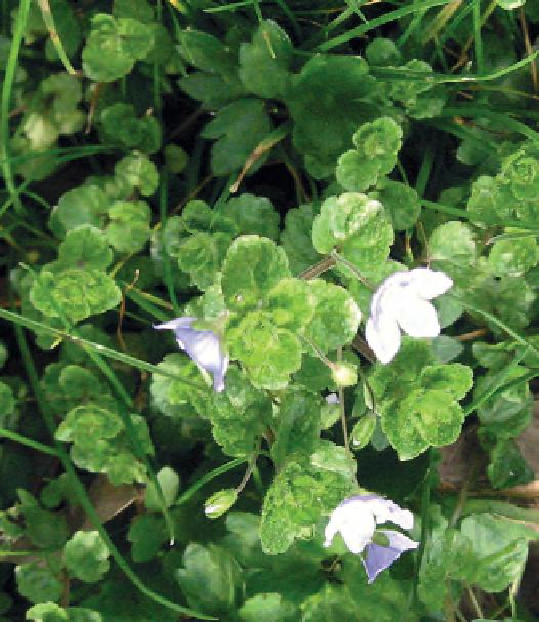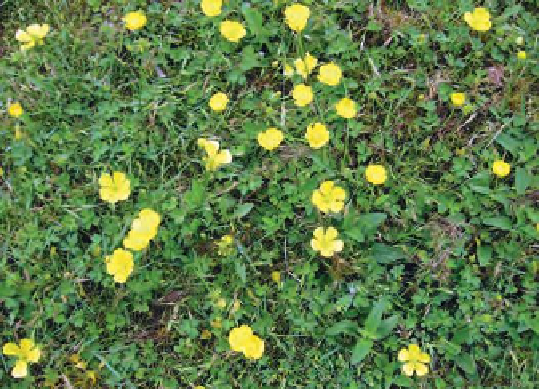Agriculture Reference
In-Depth Information
Figure 17.16
Creeping buttercup in turf spreads by
means of runners
remove the high humidity necessary for this weed's
establishment and development.
Gardeners may have difficulty controlling this weed
with the range of turf weedkillers available. Herbicides
containing
fluroxypyr
will have some effect. They
can control the weed in a turf seedbed using a
total, contact chemical such as
glyphosate
, a few
weeks
before
sowing the turf seed. This '
stale seed
bed
' method leaves the turf to establish, relatively
undisturbed by weeds. Great care is needed to avoid
spraying foliage of garden plants.
Figure 17.15
Slender speedwell plant has small
leaves and is often seen growing in turf
Veronica filiformis
produces small self-sterile purple-
blue flowers between March and May, and spreads by
means of prostrate stems which root at their nodes to
invade fine and coarse turf, especially in damp areas.
Segments of this weed cut by lawnmowers easily
root and thus increase the species. Seeds are not
important in its spread.
Spread
. Seeds of
V. persica
falling to the ground may
be dispersed by ants. Seed of this species can be
spread as contaminants of crop seed.
V. filiformis
does not produce seed. Its slow spread is mainly by
means of lawnmower activity.
Control
. Field speedwell (
V. persica
) is controlled
by a combination of methods. The cultural
action
of hoeing or mechanical cultivation, particularly in
spring, prevents developing seedlings from growing to
mature plants and producing their many seeds.
The gardener can use the herbicide
glyphosate
for control in bare soil, and in such situations as
ornamental beds containing woody perennials, and in
cane fruit but care is needed to avoid spraying foliage
of garden plants.
The slender speedwell (
V. filiformis
) represents
a different problem for control.
Cultural
controls
such as regular close mowing and spiking of turf
Perennial weeds
Seven species - creeping buttercup, ground
elder, couch, creeping thistle, yarrow, dandelion
and broadleaved dock - are described below to
demonstrate the different features of their biology
(particularly the parts of the plant that allow the plant to
survive
from year to year) that make them successful
perennial weeds. The flowering period of these weeds
is mainly between June and October but the main
problem for gardeners and growers is the plants' ability
to survive and reproduce vegetatively (see also p. 133).
The horsetails, mosses and liverworts that are
unrelated to flowering plants are covered in a separate
section (p. 94).
Creeping buttercup (
Ranunculus
repens
)
A member of the plant family Ranunculaceae.
Damage and location
. This is a common weed in turf
(Figure 17.16), especially when the soil is a heavy
clay or the location is prone to water logging. The


